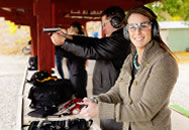





Knife Sharpening Part I By Tom Claycomb III - Today we’ll do an introduction into knife sharpening and cover blade Continue Reading

Succeeding with the Fundamentals: It’s in the Details By Michelle and Chris Cerino - The difference between a good shooter and a great shooter is in the details. Continue Reading

Succeeding with the Fundamentals: Get a Grip By Michelle and Chris Cerino - The primary role of grip is to aid in managing recoil. Continue Reading

Colt 1911 Style Pistol Info: "Standard Safety Checks"
Colt 1911 Info: Series 80 Firing Pin Block Safety Assembly:
These are the parts involved with the Colt Series 80 1911 style handguns and some copies. At the top is the plunger (visible with the slide locked open and viewed from underneath) which blocks the firing pin from moving forward unless the trigger is pulled. It is spring powered to keep the thicker end down and in contact with the firing pin. The part in the middle is the finger which rotates and pushes the plunger upwards. This allows the firing pin to pass through the narrow middle section of the plunger. This finger is moved by the lever at the bottom. The lever itself is moved by the rear of the trigger when it contacts the levers lower extension as the trigger is pulled to fire the gun. A very clever arrangement that helps prevent the gun from going off should it be dropped directly on the end of the hammer, on a hard enough surface, from sufficient height, while fully cocked with a live round in the chamber. Otherwise it does nothing useful.
In most factory guns these parts go about their business un-noticed by the user, however, almost any modification to the sear or hammer surfaces, such as in a trigger job, will almost always destroy the fragile timing of the parts and cause the gun to misfire. The parts can be removed with no ill effect on the operation of the gun so long as the two lower parts are replaced by a small frame filler plate available from Brownells for about $5.00. Removal of the plunger will only leave an empty hole in the bottom of the slide. Be aware that removing a safety mechanism in this age of political correctness could void warranties or leave you liable for damages under the unique circumstances that the safety was designed for, but at least you'll know your gun will fire should the need arise. It's up to you.

Tips on Lubrication
Let's start with what you shouldn't use - WD40 or anything like it. WD-40 is a fine light duty oil and rust penetrator.

Tips on Headspace
Headspace can be thought of as something like this: The cartridge in your chamber is in a safe with the bolt of the rifle as the door.

Handgun Tips
Cock the hammer (chamber and magazine empty of course). Without depressing the Grip Safety, pull the trigger. The hammer should NOT...
Copyright © 2015 - All Rights Reserved - Swab-its.com
Swab-its® is a registered trademark of Super Brush LLC
- Disclaimer